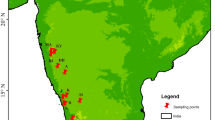Abstract
Andrographis paniculata is a medicinal plant of immense therapeutic value. The present study was aimed to elucidate its genetic diversity based on morphochemical and RAPD markers from 53 accessions belonging to 5 eco-geographic regions. Analysis of variance and D 2 statistics revealed significant differences in all the metric traits and sufficient inter-cluster distances indicating considerable diversity among the accessions. The complementary approach of RAPD was used to evaluate the genetic dissimilarities among all the accessions using 6 highly polymorphic primers. The average proportion of polymorphic loci across primers was 96.28%. The molecular genetic diversity based on Shannon index per primer averaged 5.585 with values ranging from 3.08 to 8.70 indicating towards wide genetic base. RAPD based UPGMA and D 2 cluster analysis also revealed that various accessions available in different eco-geographic regions might have originated from native places of wild abundance. Similarity matrices were generated for molecular markers and morphometric data to determine the degree of congruence between the two. A highly significant but low correlation (r = 0.547, P < 0.001) was obtained thus implying the correspondence between the two. The species is hermaphroditic and a habitual inbreeder. The present study yielded a typical triangular congruence between its breeding system, morphometric traits and RAPD markers thus elucidating the usefulness of complementary approaches to make diversity analysis more explanatory and purposeful for optimum genetic amelioration and effective conservation of its genotypic variability.





Similar content being viewed by others
References
Anonymous (1985) The wealth of India: raw materials, vol 1. Council of Scientific and Industrial Research, New Delhi, India, pp 364
Arnholdt-Schmitt B (2000) RAPD analysis: a method to investigate aspects of the reproductive biology of Hypericum perforatum. L Theor Appl Genet 100:906–911
Bookistein FL (1991) Morphometric tools for land mark data. Cambridge University Press, New York, NY
Doyle JJ, Doyle JL (1990) Isolation of plant DNA from fresh tissue. Focus 12:13–15
Kantety RV, Zeng X, Bennetzen JL, Zehr BE (1995) Assessment of genetic diversity in dent and popcorn (Zea mays) inbred lines using inter-simple sequence repeat (ISSR) amplification. Mol Breed 1:365–373
Kapil A, Koul IB, Banerjee SK, Gupta BD (1993) Anti hepatotoxic effects of major diterpenoids constituents of Andrographis paniculata. Biochem Pharmacol 46:182–185
Lattoo SK, Khan S, Dhar AK, Choudhary DK, Gupta KK, Sharma PR (2006) Genetics and mechanism of induced male sterility in Andrographis paniculata (Burm. f.) Nees and its significance. Current Sci 91:515–519
Lewontin RC (1972) The apportionment of human diversity. Evol Biol 6:381–398
Mahalanobis PC (1936) On the generalised distance in statistics. Proc Nat Inst Sci 2:49–55
Martin JP, Sanchez-Yelamo MD (2000) Genetic relation ships among species of the genus Diplotaxis (Brassicaceae) using inter-simple sequence repeat markers. Theor Appl Genet 101:1234–1241
Misra P, Pal ML, Guru PY, Katiyar JC, Srivastva V, Tandon JS (1992) Antimalarial activity of Andrographis paniculata (Kalmegh), against Plasmodium berghei NK 65 in Mastomys natatensis. Int J Pharmacogenom 30:263–274
Nei M, Lei W (1979) Mathematical model for studying genetic variation in terms of restriction endonucleases. Proc Natl Acad Sci USA 76:5269–5273
Otake T, Mori H, Morimuto LT, Hattori M, Namba T (1995) Screening of Indonesian plant extracts for anti-human immuno deficiency virus-type I (HIV-I) activity. Phytother Res 9:6–10
Padmesh P, Sabu KK, Seeni S, Pushpangadan P (1999) The use of RAPD in assessing genetic variability in Andrographis paniculata Nees, a hepatoprotective drug. Curr Sci 76:833–835
Pejic I, Ajmonc MP, Morgante M, Kozumplick V, Castiglioni P, Taramino G, Motto M (1998) Comparative analysis of genetic similarity among maize inbred lines detected by RFLPs, RAPDs, SSRs and AFLPs. Theor Appl Genet 97:1248–1255
Powell W, Morgnate M, Andre C, Hanafey M, Vogel J, Tingey S, Rafalski A (1996) The comparison of RFLP, RAPD, AFLP and SSR (microsatellite) markers for germplasm analysis. Mol Breed 2:225–238
Rao CR (1952) Advanced statistical method in biometrical research. John Wiley and Sons. Inc., New York, p 390
Rohlf FJ (1993) NTSYS-pc. Numerical taxonomy and multivariate analysis system: version 1.8. Applied Biostatistics, New York
Russel JR, Fuller JD, Macaulay M, Hatz BGB, Jahoor A, Powell W, Waugh R (1997) Direct comparisons of levels of genetic variation among barley accessions detected by RFLPs, AFLPs, SSRs and RAPDs. Theor Appl Genet 95:714–722
Saraswat B, Visen P, Patnayak GK, Dhawan BN (1995) Effect of andrographolide against galactosamine-induced hepatotoxicity. Fitoterapia 66:415–420
Saxena S, Jain DC, Gupta MM, Bhakuni RS, Misra HO, Sharma RP (2000) High performance thin layer chromatographic analysis of hepatoprotective diterpenoids from Andrographis paniculata. Phytochem Anal 11:34–36
Sneath PHA, Sokal RR (1973) Numerical taxonomy. Freeman, San Francisco
Zhang CY, Kuroyangi M, Tan BKH (1998) Cardiovascular activity of 14-deoxy-11, 12-didehydroandrographolide in anaesthetized rat and isolate right atria. Pharmacol Res 38:413–417
Acknowledgements
The authors thank Dr. G.N. Qazi, Director Regional Research Laboratory (CSIR) for useful discussions. One of us (S.B.) was in receipt of research fellowship from GBPIHED, Almora, India, whilst the work was being carried out.
Author information
Authors and Affiliations
Corresponding author
Rights and permissions
About this article
Cite this article
Lattoo, S.K., Dhar, R.S., Khan, S. et al. Comparative analysis of genetic diversity using molecular and morphometric markers in Andrographis paniculata (Burm. f.) Nees. Genet Resour Crop Evol 55, 33–43 (2008). https://doi.org/10.1007/s10722-007-9212-y
Received:
Accepted:
Published:
Issue Date:
DOI: https://doi.org/10.1007/s10722-007-9212-y




